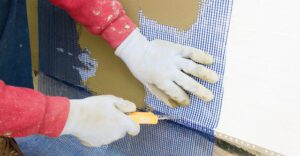Stucco Repair
If your stucco is showing signs of damage, you may need to repair it. Stucco is a masonry material that protects the exterior walls of your home from moisture and mold.

Stucco Repair Philadelphia is easy to do if you know what you’re doing and have the right materials. However, if the problem is more severe, you’ll need to call in an expert like Stucco Repair Philadelphia.
Stucco is a time-tested wall covering that’s made from a mixture of Portland cement, sand, and water. It’s strong enough to be used on bridges and skyscrapers, and it also serves as an excellent form of insulation.
However, stucco isn’t immune to damage from weather factors. When it’s hit by hail, a soccer ball, or another heavy impact, it can leave circular indentations that need repair.
In some cases, the indentations may look like cracks and require a stucco professional to inspect and make repairs. These types of cracks can also indicate rotting wood beneath the stucco or water intrusion problems that need a full inspection and treatment.
While small hairline cracks on your stucco aren’t caused for alarm, a large or jagged crack could be a sign of structural problems. These types of cracks often appear due to settling or expanding issues with the home’s foundation or moisture that’s getting behind your stucco, says Cantor.
If you’ve noticed multiple cracks in your stucco, it’s a good idea to call a stucco repair expert to investigate the problem further and determine what’s going on. This will help you find the best solution to your stucco repair needs and ensure that your home’s walls aren’t vulnerable to additional moisture or rot in the future.
For smaller holes and fissures in your stucco, it’s probably a good idea to patch them with special stucco repair material. Once the repair is dry, you can paint over it if you want to hide the imperfections.
Other signs of impact damage on your stucco include staining or blistering. Blisters can happen when loose pieces of stucco crumble off, while staining is a sign that the underlying layer of your stucco has been damaged and will need to be retextured and painted in order to restore its appearance.
Whether you have a small or large area of stucco that’s affected by impact damage, it’s important to get stucco repair done as soon as possible. Depending on the amount of damage, you may need to replace the entire section or repair it with special stucco materials.
Stucco is an eco-friendly, durable building material that can improve the appearance of a home while also acting as a weatherproof insulator. It is often used in historic buildings, but modern homes may also feature stucco, which is a mixture of limestone, concrete, and sand.
Stains on exterior stucco can be caused by dirt, soot, rust, or mold. They can also be a sign of an underlying problem that requires the attention of a professional.
If you notice stains on your stucco, it is important to act quickly. If left untreated, these stains can lead to permanent damage and costly repairs.
While a few stains on stucco can be removed with a good cleaning solution and pressure washer, others can be difficult to remove and will require a more thorough approach. If you encounter a particularly stubborn stain on your stucco, consider purchasing a soft-bristled brush to help scrub the area.
Some stains on stucco can be caused by algae or mold growth. Algae stains can be removed by using a cleaning solution and a soft bristle brush. Mold stains can be a bit more labor intensive, but once they are removed, they can usually be cleaned with a soap and water solution.
Efflorescence can be another issue that can cause a hazy look to your stucco walls. This happens when water seeps through the material and dissolves salts. Afterward, these salts evaporate and leave a white crystalline deposit on the surface of your stucco.
Aside from stains on your stucco, it’s also important to check for cracks in the material. These cracks can allow moisture into the wall and drywall, which can then grow mold. The resulting mold can also be very dangerous, so if you notice any signs of discoloration in your stucco, get it fixed as soon as possible.
